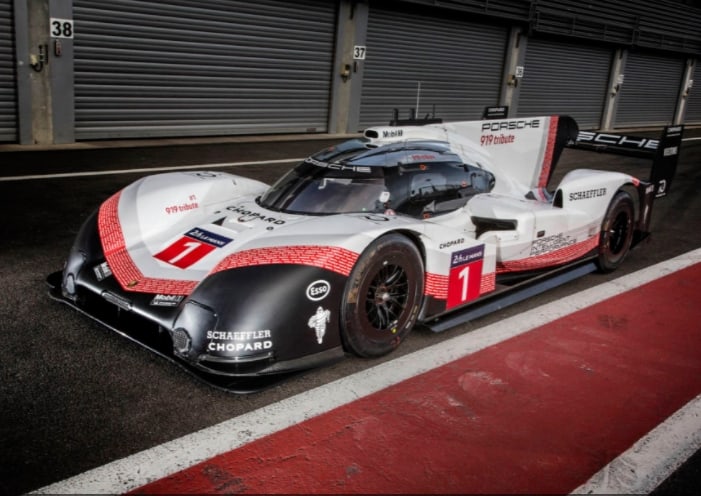
For a few glorious years, the “P1” prototype class in the World Endurance Championship (WEC) was the coolest thing in racing. Audi, Toyota, and Porsche built all-wheel drive hybrid racecars, each with more than 1,000 horsepower, each capable of running flat-out for 24 hours or longer over distances it would take an F1 car an entire season of races to rack up. But Audi and then Porsche both withdrew from the sport, their highly successful—but very expensive—racing programs casualties of Dieselgate. Porsche pulled out at the end of 2017 after winning almost everything there was to win with its 919 Hybrid. But before the company puts the cars into the museum, it has some unfinished business, proving just how insanely fast the 919 Hybrid really is.
Porsche is taking the 919 Hybrid on tour, but the plan is to do more than just show it off to the fans—it’s going for records. The first of these has already fallen. On Sunday, April 9, Neel Jani set a new track record at Spa-Francorchamps in Belgium, home to that country’s annual F1 race. Jani lapped the 4.4-mile (7km) track in 1 minute 41.770 seconds, 12 seconds faster than the 919 Hybrid’s previous best time at the track.
Let’s put that in more context. In last year’s Belgian Grand Prix, Lewis Hamilton set a new lap record at Spa during qualifying with a lap time of 1:42.553—0.783 seconds slower. To make this new feat even more impressive, Porsche set that time in weather barely warm enough for the tires to switch on—the ambient temperature was just 12 degrees Celsius (53.6 degrees Fahrenheit) compared to 17 degrees Celsius (62.6 degrees Fahrenheit) for the F1 event that took place in August.
The powertrain of the car—now called the 919 Evo—was mechanically the same as raced in 2017. It’s a 2.0L turbocharged gasoline V4 engine driving the rear wheels, coupled to a motor-generator unit (MGU) at the front axle and a second energy recovery unit that harvested electricity from the exhaust. Both energy recovery systems charged a lithium-ion battery, and that energy was used by the MGU to drive the front wheels.
But the technical regulations of the WEC imposed some limits on the cars in order to keep performance within a range the organizers considered acceptable. Among other things, this included a fuel flow restriction—1.784kg of fuel (2.464L or 0.6 US gallons) a lap. What’s more, the hybrid systems were limited in the amount of energy they could deploy each lap. In 2017, this was just 6.37MJ.
This is how fast it really goes
Now that the 919 Evo isn’t racing, Porsche doesn’t have to abide by any of those restrictions. It’s still running the same race fuel, but new engine management software has bumped power on the internal combustion engine from 500hp (373kW) to 720hp (537kW). And with 8.48MJ now coming out of the battery, the hybrid system is 10-percent stronger at 440hp (328kW).
Porsche’s aerodynamicists have also been given a free hand. There’s a new front diffuser and a much bigger rear wing. And both are active, which means they can change profile to minimize drag on the straights and maximize downforce in the turns (two tweaks that are good for lap time). Porsche says the 919 Evo has 53-percent more downforce and is 66-percent more aerodynamically efficient compared to the bodywork it used in the Six Hours of Spa-Francorchamps in 2017.
Other changes to the 919 Evo included stronger suspension wishbones and new power steering to cope with the higher cornering loads, a new brake-by-wire system that added some more yaw control, 86lbs (39kg) of weight reduction (total overall weight: 1,871lbs or 849kg), and new tire compounds courtesy of Michelin that maximized grip.
According to Stephen Mitas, chief race engineer for the 919 Hybrid, letting the car off the leash was a dream come true:
Having developed, improved and raced the car for four years, the guys had a very close relationship to it. We all knew, no matter how successful the 919 Hybrid was, it could never show its full abilities. Actually even the Evo version doesn’t fully exploit the technical potential. This time we were not limited by regulations but resources. It is a very satisfying feeling that what we’ve done to the car was enough to crack the Formula One record.”
If you want one last chance to see the 919 drive in anger, Porsche will be bringing it to the Nürburgring (including a demo lap on the fearsome Nordschleife) on May 12, then the Goodwood Festival of Speed (July 12 to 15) and the Festival of Porsche at Brands Hatch (September 2), both in the UK. The final outing will be at the Porsche Rennsport Reunion at Laguna Seca in California (September 27 to 30).
Toyota also took the cuffs off
There are still quite a few opportunities to see the last of the P1 hybrids race, however. Audi and Porsche might have pulled out, but Toyota Gazoo Racing is still taking part in the WEC’s “Super Season,” which gets underway next month at Spa and continues all the way through until the 2019 24 Hours of Le Mans. The US round will be a 1,000-mile or eight-hour race on March 15 at Sebring in Florida, the day before IMSA’s 12-hour race takes place.
This past weekend, the teams of the WEC took part in their annual preseason test at Paul Ricard in France. And there, too, we got a glimpse of the raw speed of an unleashed factory hybrid racer. On the first day of the test, the Toyota TS050s were blisteringly quick, with Mike Conway setting an overall fastest lap of 1:32.662. That was five seconds faster than the non-hybrid, privateer P1 cars that make up the rest of the class for the Super Season and four seconds faster than the last time hybrid P1 cars tested at Paul Ricard.
For a day or so there was much consternation over the speed differential, until Toyota explained the real reason: on Friday the cars weren’t bound by fuel flow or energy limits, and the team turned everything to 11 to stress-test a new cooling system. Unlike the 919 Evo, Toyota was running with homologated bodywork and on its regular tire compounds.
























